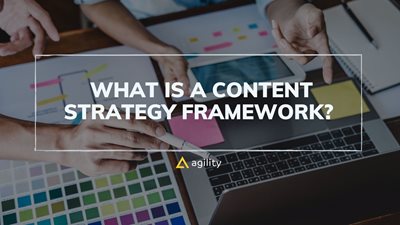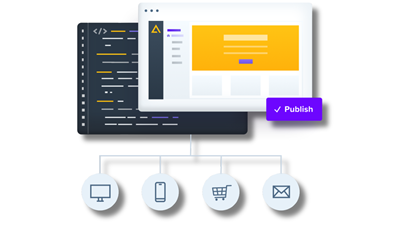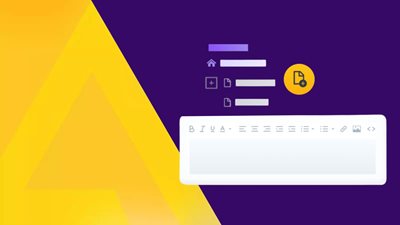What is a content strategy framework?
Create an action plan that will knock your competition out of the park!


Check Out the Updated Version: Content Strategy Framework: A Modern Guide For 2025
Having a content marketing framework is pivotal to planning and implementing successful campaigns.
When you have a content strategy framework, you don’t rely on SEO efforts — as important as they are. Instead, you marry the efficacy of SEO with the personalization of customer-centric marketing.
In other words, you bridge the gap between what search engines say and what your audience needs.
In fact, in a mid-2019 survey conducted among global marketers, 77% said they had a content marketing strategy in place for their organization.
And we can see why.
When you have a content strategy framework in place, you have direction, consistency, and a concrete plan to test and refine. No more creating content based on confusing spreadsheets. No more conjecture. No more random testing. Every decision you make has a palpable goal and a smart action plan that supports it.
You're in the right place if you’re still wondering what a content strategy framework is.
In this article, we’re breaking down what a content strategy framework is and the benefits of having one. We’re also sharing how to build a content strategy framework step-by-step.
What is a content strategy framework?

If you’re still wondering what a content strategy framework is, this section will clear the air for you.
In short, a content strategy framework is an action plan you’ll use to create, manage, and publish content. You’ll refer to it anytime you host a content marketing meeting, plan your content calendar, and publish your campaigns.
You can think of a content strategy framework as a master guide that informs your content marketing efforts. Just like a business plan lays out your enterprise’s growth strategy, a content strategy framework outlines your organization’s content scalability plan.
What does a content strategy framework consist of?
A content strategy framework is a blueprint you create that details your goals, audience, funnel stages, and content types. You can also outline the tools you’ll use, the people in charge, and the systems and processes you’d like to put in place.
Some of the key elements of a successful content strategy framework include:
- Why you’re creating content
- Who your content is for
- How your content factors into the buying process
- How you’re going to create content
- What systems and processes will run your content marketing efforts
- Who’s in charge of what
What are the benefits of having a content marketing framework?
A content strategy framework is an integral component of business process design.

Why?
Because successful businesses run on systems and efficiency. The most important pillars to any business’s success are the considerations and processes behind it.
In other words, if your goal is to create content that converts, you need to know the how, why, and the system behind it all.
Here are some other benefits of having a content strategy framework.
Consistency
Having a content strategy framework in place means staying consistent on all fronts.
When you have an action plan, it’s easier to show up and deliver value to your audience. More importantly, when you show up consistently, you build credibility and trust — an absolute must for long-term customer loyalty.
Predictability
When you know what kind of content you’re creating and who you’re creating it for, you build predictability.
Not only does predictability make your marketing strategy more stable, but it also makes it easier to measure, test, and scale.
In other words, when you don’t know what kind of content you’re creating or who you’re creating it for, you’ll end up with inconsistent, unpredictable content that’s difficult to test and grow.
Easier to duplicate, package, train
When you have a game plan that works, it's easier to duplicate it for future use.
That means you can take your action plan and tweak it for a variety of audiences or package that plan and sell it to others for a profit.
Another benefit of having a content strategy framework is effectively training your content marketing team. Not only is a framework a great resource for onboarding new employees, but it’s also a helpful training tool to use with current employees who’d like to sharpen their skills.
Connect deeper to your audience
It may not sound like it, but a content strategy framework helps you humanize your content.
When you bridge the gap between what search engines say and what your audience needs, you connect with prospects in a profound way.
Why?
Because your framework was created with them in mind. It was created after asking hard questions and digging deep into your audience’s concerns and potential touchpoints.
When your foundation is built on your audience, creating content that connects — and converts is natural.
How to build a content strategy framework
Now that we’ve laid the foundation let’s explore how to build a content strategy framework step-by-step.

Step 1: Set goals and objectives
Before embarking on any kind of business endeavour, it's vital to outline your goals.
We shared why a content strategy framework is important from our experience, but what about you? What are you looking to gain? What are you looking to achieve? And how can a framework help you get there?
In this step, spend some time outlining your goals and objectives.
Keep it simple and specific by focusing on the template: what + why + how.
For instance, are you looking to drive traffic to your website? In this case, your goal might sound like this:
“I’d like to increase our website traffic by 10%. We’ve noticed that the higher our website traffic is, the higher sign-ups we have for our programs. We’d like to drive website traffic by adding more ultimate guides and 3000-word articles to our blog.”
Step 2: Consider what problems you’re going to solve
The mark of every great business is solving problems.
So, in this step, ask yourself what problems your content will solve and what solutions you’ll provide to solve them.
By digging deep and focusing on solving your audience's problems, you can make sure your content and offers will always be unique and valuable. This is also an effective practice to use when you need clear insight into what types of content can help your enterprise stand out.
Step 3: Consider what sets you apart from your competition
Why should your target audience pay attention to what you have to say? Why should they purchase your goods and services? Why should they tell their friends about you? Why should they choose you over the competition?
To set yourself apart from the competition, you need to know your strengths and how you can solve pain points better than anyone else.
In this step, outline what specifically sets you apart from your competitors.
For instance, does your product come with a five-year warranty, video tutorials, and 24/7 customer support? Do you upgrade group coaching clients to one-on-one calls if they follow through on your 30-day program? Is your SaaS product the only one on the market that offers a client portal with in-app messaging?
Whatever it is, highlight what makes you special.
Step 4: Know your audience
Hone in on a clear-cut target audience. What does their user behaviour look like? What touchpoints do they typically have with your business?
In this step, refer to your buyer personas and get to know them deeply. Then, segment your audience by type and funnel stage.
Next, ask yourself how you can support your audience segments during each touchpoint on the buyer’s journey. What types of content can you create to match where they’re at in the funnel at all times?
For example, customers who are at the research stage of the buyer’s journey can benefit from quiz landing pages that give solutions to their problems while positioning your product or service as the ultimate solution. This is a win-win for both the customer and for you.
Step 5: Consider what’s in it for your audience
Why should your audience digest your content? What’s in it for them?
In other words, how does your audience benefit by reading your content?
Do they get to walk away with life-changing advice? Do they get free access to tutorials and webinars? Do they get to sign up for valuable contests, challenges, and giveaways?
In this section, consider what your audience will get out of reading your content. Then, brainstorm a list of irresistible calls to action that can drive that forward.
Step 6: Audit your current plan and content
If you’ve already started building and marketing content, spend time auditing your current content and strategy. You can skip this step if you haven’t created any content yet.
When auditing your content, ask yourself what’s going wrong.
What metrics are you not hitting? What goals are you not achieving? What pain points are you not solving? What types of content are you missing? Drive this home further by hiring a focus group to review your work for you.
Then, spend some time brainstorming tangible solutions to update your current content and inform your future content.
Step 7: Choose your content formats and channels
In this step, consider what types of content formats you’ll focus on, which channels you’ll publish on, and how you’ll manage content creation and publishing.
To give you a leg up, most content formats focus on the following three points:
- Thought leadership content
- Awareness content
- Sales content
Take this a step further by listing micro-content types under each main header. For instance, you might want to write an ultimate e-commerce guide for awareness content or software listicles when it comes to sales content. In whichever direction you go, be sure you’re tracking and measuring important marketing KPIs to see how well your content performs.
Next, consider where you’ll be publishing your content and how you’re going to manage content creation and publishing.
Step 8: Choose the right content tools
Now that you know what your goals are, who your audience is, and how you're going to serve them, it's important to choose the right tools to get you there.
Of course, you’ll need simple content tools, like an SEO tool, a grammar checker, and a plagiarism checker. But what about managing the machine of it all?
That’s where a content management system comes in — and we happen to know the best one on the market.
It’s called Agility.
With Agility, you can quickly create, publish and manage content across a growing number of digital channels. Agility’s intuitive UI and familiar authoring experience mean even non-technical teams can deliver exceptional omnichannel experiences.
Wrap up
Ready to elevate your content strategy? Check our our content architecture eBook!

About the Author
Harmonie is the Senior Marketing Manager at Agility CMS



